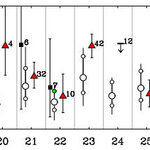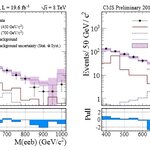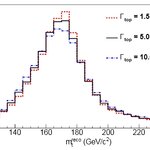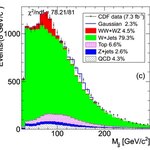Physics

Stacy McGaugh, professor of astronomy at Case Western Reserve, and Mordehai Milgrom, the father of Modified Newtonian Dynamics (MOND) and professor of physics at Weizmann Institute in Israel, say the MOND modified law of gravity correctly predicted, in advance of the observations, the velocity dispersion - the average speed of stars within a galaxy relative to each other - in 10 dwarf satellite galaxies of the Milky Way's giant neighbor Andromeda.
The relatively large velocity dispersions observed in these types of dwarf galaxies is usually attributed to dark matter. Modified Newtonian…

The spinorial space-time that I suggested in 1996-7 [1,2] naturally predicts a privileged space dimension for each observer. This was emphasized in some of my recent works [3,4], well before the Planck collaboration wrote on March 21-22 [5] :
http://sci.esa.int/planck/51559-hemispheric-asymmetry-and-cold-spot-in-the-cosmic-microwave-background/
Two Cosmic Microwave Background anomalous features (...) are confirmed (...). One is an asymmetry in the average temperatures on opposite hemispheres of the sky (...).
(end of quote)
and on March 21, Nature News reported on this issue [6] :
http://www.…

Yesterday CMS published the results of a new search for a heavy partner of the bottom quark, by looking for the decay b' -> bZ: that is, the heavy b' is sought in a so-called Flavour-Changing neutral current process. The "neutral current" is an old but still used terminology to indicate the emission of a neutral vector boson, the Z.
Neutral currents, unlike charged currents (W emission) cannot change the flavour of a quark in the Standard Model. However, if we consider new quarks with vector-like properties (a way of saying that the quark couples symmetrically to vector bosons regardless…

Despite the shutdown of the Fermilab Tevatron collider, two years ago, and the subsequent disassembling of the glorious CDF detector, the CDF Collaboration continues to produce excellent physics results using the large bounty of data they have accumulated in the course of the past 10 years.
Today you can find in the Cornell arxiv a new paper by CDF, which describes a new very interesting measurement of a property of the top quark - the particle discovered at Fermilab in 1995, the heaviest known elementary particle we know. The property measured is the lifetime of top quarks.
Because top…

Note: this is the fourth, and last, part of a four-part article (see part I, part II, part III) on the five-sigma criterion for discovery claims in particle physics. If you haven't read the first three installments, the text below may or may not make much sense to you... Below I first add some information about the dijet resonance of CDF which was the subject of part III, then I deal with one last topic to be considered, and then summarize the discussion.The last word on the CDF dijet mass bump at 150 GeVTo complement the story I told in the third part of this article I must produce an…

In 1937, Dirac made the bold conjecture that since the big bang, gravity has been weakening. The cold reception that greeted his highly speculative and numerology-based cosmology paper didn't seem to hurt him much. This was a decade after Dirac discovered the quantum relativistic equation for the electron, and his mega-stardom status could take a few hits without getting eroded significantly. Still, during the rest of his productive life, Dirac stayed away from cosmology and shrinking gravity models.
Since Dirac's failed attempt, shrinking gravity models have lingered in the background. In…

Note: this is the third part of a four-part article on the Five-Sigma criterion in particle physics. See part 1 and part 2 to make more sense of the discussion below.In this third part I want to examine in some detail a few additional specific factors that have the power of creating the conditions of false discoveries in fundamental physics: Background mismodeling, A Posterioriness, and (involuntary or else) data manipulation. I will leave the conclusions to a fourth part of this article.
Background MismodelingLoosely connected to the look-elsewhere effect is the issue I will call "…

In the previous installment of this longish article, I have introduced some of the issues that may affect the correct interpretation of a statistically significant effect. Below is the second part, dealing with the Rosenfeld paper and trying to address the questions I posed a few days ago; a third and a fourth section should be read after that, which discuss some additional factors and draw some conclusions...
Enter RosenfeldIn 1968 Arthur Rosenfeld wrote a paper, titled "Are There Any Far-out Mesons or Baryons?". In it, he demonstrated that the number of claims of discovery of such exotic…

A pre-emptive warning to the reader: the article below is too long to publish as a single post. I have broken it out in four installments. After reading the text below you should continue with part II, part III, and part IV (which includes a summary).
---
During the last few years science popularization magazines, physics blogs, and other outreach agents have been very busy, and in general successful, at explaining to the public the idea that a scientific discovery in physics research requires that an effect be found with a statistical significance exceeding five standard deviations.
Alas, I…

Here's a development that could have significant implications for electrochemistry, biochemistry, electrical engineering and many other fields: a Nature Materials paper is about computer simulations which find that the electrical conductivity of many materials increases with a strong electrical field in a universal way.
Electrical conductivity is a measure of how strongly a given material conducts the flow of electric current and is generally understood in terms of Ohm's law, which states that the conductivity is independent of the magnitude of an applied electric field, i.e. the…